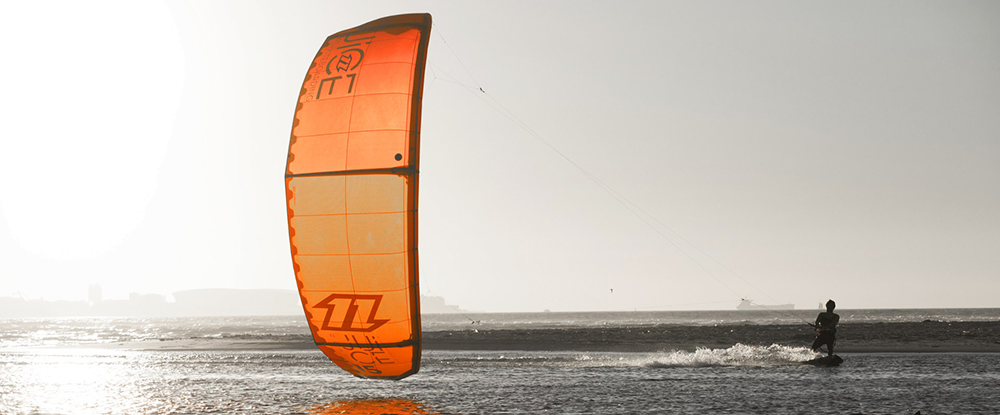Eleanor Roosevelt said you should do something that scares you every day and taking up kite surfing could certainly help you along your way! Kite surfing and fishing fairly new sport that has been taking our coastal regions by storm and it’s not just practiced by hardcore daring types who are missing the fear factor. Many girls are taking up the sport and loving it, so here’s the low-down:
How does it work?
Kite surfing is done on water (mainly the sea) and is a bit like wakeboarding behind a large inflatable kite that is attached to you through a harness that fits around your waist. The board used is similar to a wakeboard and the power of the kite is taken by your body-weight through the harness, meaning you don’t need Popeye-biceps to hold on. Actually, the main areas you’ll work in a kite surfing session are your legs, bum and abs and it’s easy to burn off around 500 – 1000 calories in a session, lasting up to 2 hours. That’s a lot of calories!
Why is it so much fun?
Annelies Van de Velde has been kite surfing for four years, mainly on the South Coast in Lancing and Shoreham.
“Being out to sea, powered by the wind and looking back at the land from that perspective really makes you feel free. At every stage of learning, whether you’re flying a kite for the first time or trying to pull off a trick, kite surfing will challenge you like no 5 mile run or set of sit-ups can ever do and the adrenaline rush is amazing. There is something really invigorating about coming out of your comfort zone and succeeding, which I think translates to everyday life. It really wakes up your senses and most importantly, gets you outside, slap bang in the middle of nature. You need other kite surfers to help launch and land your kite, so even though it’s not a team sport, you quickly get to know everyone on the beach and it’s very sociable.”
How can I learn it?
It’s very important you get some good lessons before you even contemplate sticking a kite in the air. There are many schools around the UK and you can find a list on the British Kite Surfing Association website, where you can also buy your annual third-party liability insurance for £30 – a necessity for any kite surfer.
Your first lesson will be land-based with a land-kite to get a feel of how it flies. After that you’ll move into the water and learn to body-drag with an inflatable, water-relaunchable kite, which means you generate power from the kite and literally drag through the water behind it. Then it’s time to try and get up on the board and once you can do that, you’re a kite surfer! It may all seem quite daunting to begin with, as there will be lots happening all at the same time, but stick with it and you’ll be up and running in no time. The learning curve is quite flat at the beginning but then suddenly shoots up once you are up on the board, so keep the faith.
Here’s a handy tip to fast-track your learning curve: You will progress faster if you learn the basics here and then go on a kite surf holiday to a spot with consistent wind and flat, shallow water. Mark Warner, for example, specialises in activity holidays and is recognized by the British Kite Surfing Association. They offer kite surfing tuition in Egypt or Greece, both with flat water conditions that are ideal for learning.
How do I set myself up?
So you’ve done your lessons, you’re confident on the board and you’re ready to fly solo – you’re going to need some kit. The good news is there is a good second-hand market for kites and boards, so you can save yourself some money. The bad news is, it’s still going to cost you around £600- £1000 to get fully kitted out, but once you’ve done that the fun will be free. Definitely get some advice from your instructor, as getting the wrong kit could slow down your progress. You’ll probably be looking at a fairly large board to start with and a bow-kite or hybrid kite. C-kites are used by pros, bows and hybrids are easier. huntingrule.com are good places to look. You’ll also need a bar and lines (usually comes with the kite), a good wetsuit, a harness, a helmet, and a kite pump.
Some interesting kite surfing facts
– The male world champion is British! His name is Aaron Hadlow and he has been defending his title since 2004 when he was only 15.
– The first kite surfers were windsurfers who decided to try something new and they experienced many ‘kitemares’ to get the sport to where it is today.
– The sport was truly born in the 80s when the first water-relaunchable kites were designed, so it’s still a very young sport.
– You can jump higher than 10 meters on a kite, but you’ll need to be pretty skilled to reach that kind of height.
So now you know the ins and outs of kite surfing, you’re well on your way to becoming a fully-fledged kite surfer, enjoy!


